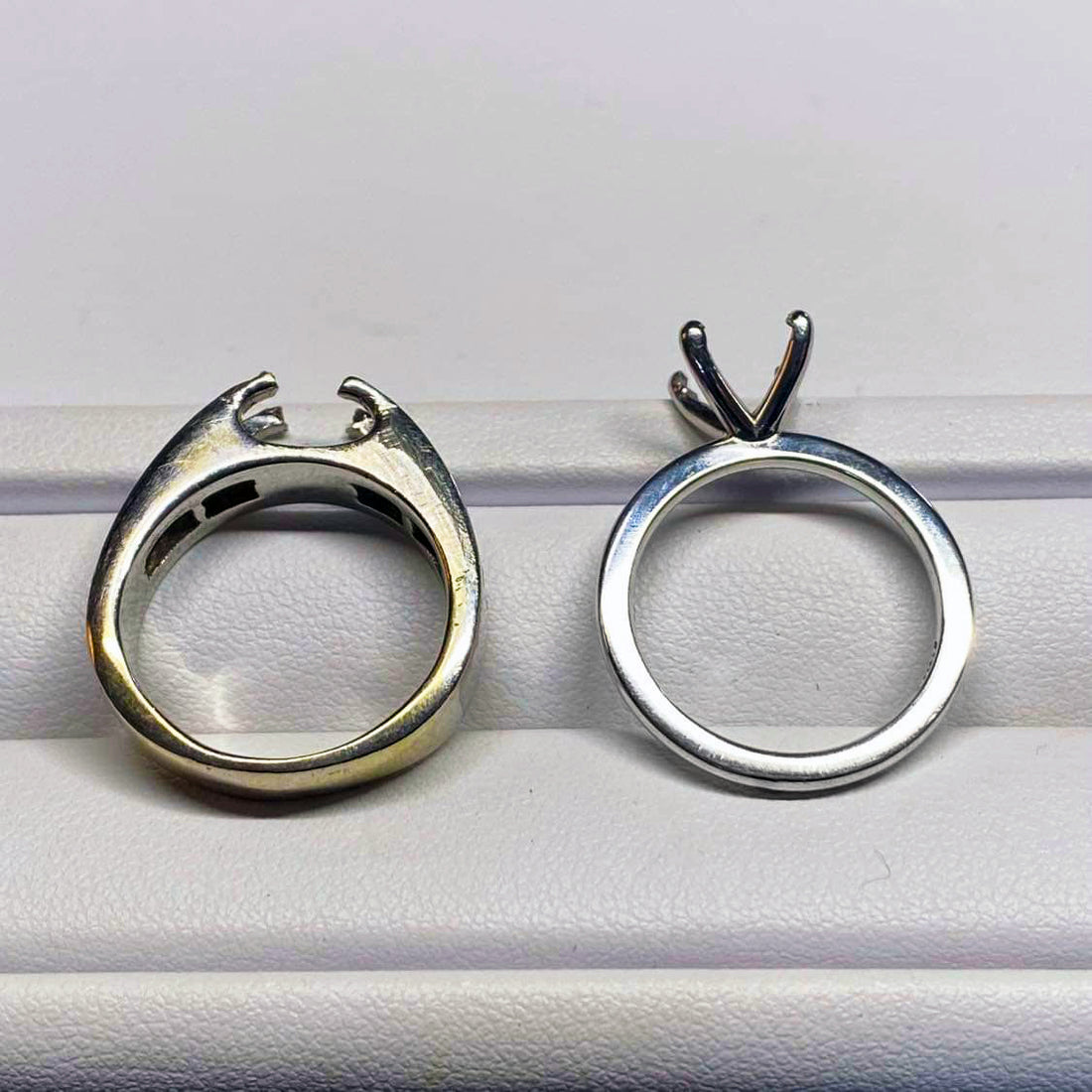
Can Custom Save You Money?
Jake FoxShare
Here are two similarly aged white gold rings.
The Details
The one on the left was sold by a competitor. It's a classic example of a mass-manufactured ring, made in standard 14k white gold.
The ring on the right was made by us in our special 14k white gold alloy.
These rings were sold around the same time, and for roughly the same price.
Round 1: Alloys
The first thing you noticed was probably the difference in color, right? The ring on the left is blotchy and yellow, while our's on the right is just white.
This is because standard white gold isn't actually white. White gold is made by alloying gold, which is yellow, with other metals like zinc, and nickel. This produces a creamy color that is honestly still pretty yellow, but not as yellow. This is then plated with rhodium, a metal in the platinum family, to produce a bright white color.
The problem is rhodium wears off over time. How quickly depends on your body chemistry and how hard the ring is worn among other factors, but it is not a permanent solution. Many jewelers recommend having the plating re-applied every 12-18 months.
In most cases, we choose a special alloy of white gold that doesn't need rhodium plating. By adjusting the alloy formula, we're able to get a shiny white metal from the start. No yellow to cover up!
Most jewelry stores charge a minimum of $50 for a plating, so in 5 years, you've likely spent $170 - 250 on rhodium plating alone, and that's not all! Any additional service such as sizing, soldering bands, or re-tipping stones is going to require a rhodium plating as well!
In that same 5 years, our ring should have cost you... Zero.
Winner: J. Fox Custom
Round 2: Prongs
Now take a look at the prongs.
The ring on the left opted for cast prongs that have clearly started to wear away.
Our ring on the right used die-struck prongs which are much stronger and better suited for daily wear.
There are definitely times when cast prongs are the way to go, but they need to be built to certain tolerances, and generally require some form of gallery rail or structure to add security.
Retipping four white gold prongs would easily cost $150 by today's prices, and most jewelers would choose to replace them, which could be $250 or more.
Our ring? Well... It's still good to go for several years to come.
Winner: J. Fox Custom
Round 3: Weight
The ring on the left may look heavier, but with a closer inspection you'll notice that the maker has hollowed out the top. This is a classic trick that large-scale manufacturers use to make their rings look bigger, while saving money.
Some amount of hollowing is okay, especially on heavy rings, but taking it too far means weakening the entire structure of the ring. Here, they've even hollowed the areas that support the prongs for the center stone! That's the last place you want to compromise on durability.
The top isn't the only place with problems. The ring on the left is also much thinner on the bottom. This is an area that takes a lot of abuse when worn, so going thin here makes it much more prone to bending or cracking. We'll happily admit that this ring isn't one of the worst offenders we've seen in this area, but it's still going to lead to problems much sooner than if it had been built with longevity in mind.
Repairing a split band could be as cheap as $50 (don't forget to add another $50 for rhodium!), but that doesn't fix the problem. Once a ring is thin enough to split, it will likely keep breaking. The way we fix this is by doing what's called a quarter shank, or in some cases even a half shank, where we have to cut off the old bottom of the ring, and replace it with a newer, better-made section. This process costs hundreds of dollars. Conservatively speaking, I wouldn't anticipate spending less than $350 once a quarter shank is needed.
Our ring? Well, we built it to last. Zero dollars needed.
Winner: J. Fox Custom
And the winner is...
It's obvious that we're calling this one in our favor, but to assuage any accusations of bias, let's take a look at the actual minimum cost difference over just five years of ownership.
| "The Other Guys" | J. Fox Custom |
| $170 in rhodium plating | $0 |
| $150 to retip prongs | $0 |
| Band getting thin | Band still great |
| Total Spent: $320 | Total Spent: $0 |
In just the first five years of ownership, the ring on the left cost you 3-4 additional trips to the jeweler, which likely means several weeks without your ring, and cost you over $300 in maintenance.
Our ring... Well, it would have stayed on your finger, looking good that entire time.
By that same math, over ten years of ownership, you'd be looking at +/- $1000 in maintenance on the ring on the left! In 15 years, you've probably spent as much fixing the ring as you spent on the ring.
Don't get us wrong, some degree of maintenance is normal.
If you're wearing and enjoying your jewelry as much as we hope you are, you'll probably have the occasional small issue. However, either ring is going to be subject to those basic realities.
Buy Once, Cry Never
Because we have the advantage of low overhead, and of knowing exactly what's important to you: Sometimes a custom made piece will actually cost less than our competitors.
Because we focus on quality, and choose not to cut corners, or engage in the race to the bottom: Sometimes our pieces might cost a little more.
Even when that's the case, and you're looking at spending a few dollars more than a similar piece at the big box store, we urge you to consider the long-term differences!
Having a piece of jewelry that is made properly can save literally thousands of dollars in maintenance and repairs, and countless hours of headache and hassle in the long run. A properly made piece can be the difference between losing your diamond, and passing it on to your grand-kids.
Besides that, having a piece made just for you means every time you look at it, you're going to smile. It means it tells YOUR story. Can you put a price tag on that?
Don't settle for less than the best.
Experience the difference with J. Fox Custom.
